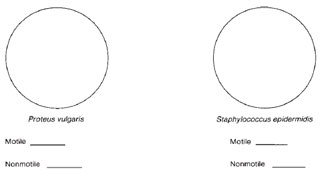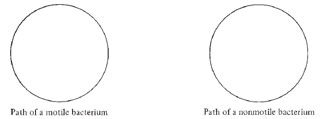Preparing a Hanging Drop
| Purpose | To observe bacteria in a hanging drop, study their morphology, and determine their motility |
| Materials | 24-hour broth culture of Proteus vulgaris mixed with a light suspension of yeast cells 24-hour broth culture of Staphylococcus epidermidis mixed with a light suspension of yeast cells 2 hollow-ground slides Several cover glasses Wire inoculating loop Bunsen burner or bacterial incinerator China-marking pencil or permanent marking pen Petroleum jelly |
Procedures
- Take a cover glass and clean it thoroughly, making certain it is free of grease (the drop to be placed on it will not hang from a greasy surface). It may be dipped in alcohol and polished dry with tissue, or washed in soap and water, rinsed completely, and wiped dry.
- Take one hollow-ground slide and clean the well with a piece of dry tissue. Place a thin film of petroleum jelly around (not in) the concave well on the slide (fig. 3.1, step 1).
- Gently shake the broth culture of Proteus until it is evenly suspended. Using good aseptic technique, sterilize the wire loop, remove the cap of the tube, and take up a loopful of culture. Be certain the loop has cooled to room temperature before inserting it into the broth or it may cause the broth to “sputter” and create a dangerous aerosol. Close and return the tube to the rack.
- Place the loopful of culture in the center of the cover glass as in figure 3.1, step 2 (do not spread it around). Sterilize the loop and put it down.
- Hold the hollow-ground slide inverted with the well down over the cover glass (fig. 3.1, step 3), then press it down gently so that the petroleum jelly adheres to the cover glass. Now turn the slide over. You should have a sealed wet mount, with the drop of culture hanging in the well (fig. 3.1, step 4).
- Place the slide on the microscope stage, cover glass up. Start your examination with the low-power objective to find the focus. It is helpful to focus first on one edge of the drop, which will appear as a dark line. The light should be reduced with the iris diaphragm and, if necessary, by lowering the condenser. You should be able to focus easily on the yeast cells in the suspension. If you have trouble with the focus, ask the instructor for help.
- Continue your examination with the high-dry and oil-immersion objectives (be very careful not to break the cover glass with the latter). Although the yeast cells will be obvious because of their larger size, look around them to observe the bacterial cells.
- Make a hanging-drop preparation of the Staphylococcus culture, following the same procedures just described.
- Record your observations of the size, shape, cell groupings, and motility of the two bacterial organisms in comparison to the yeast cells.
- Discard your slides in a container with disinfectant solution.
You must be careful not to mistake movement caused by currents in a liquid for true motility. If a wet mount is not well sealed or contains bubbles, air currents set up reacting fluid currents, and you will see organisms streaming along on a tide.
Results
- Make drawings in the following circles to show the shape and grouping of each organism. Indicate below the circle whether
it is motile or nonmotile. How does their size compare with that of the yeast cells in the preparation?

- In the following left-hand circle, draw the path of a single bacterium having true motility. In the right-hand circle, draw
the path of a single nonmotile bacterium.





